Doctor Strange is about as weird as any Marvel movie is going to get these days, which is not particularly weird. Even to fans of the Marvel Cinematic Universe—and this certainly includes me —the Marvel movies are taking on an undeniable similarity in construction. How could they not? They must: a) Introduce us to new characters and provide their backstory; b) Tie into an existing universe that is now nearly 20 movies large; c) Tell a self-contained story that nevertheless must flow out of the previous film and flow into the next one; d) Maintain the same look, feel and pace of every other film in the franchise.
Some stories are more inventive than others, but only up to a point. These movies are beginning to feel like they require a night in the library—or an hour on Wikipedia anyway—just to know enough to watch them. Writing about them as a single entity is beginning to feel like trying to put an out-of-context chapter of a novel that will never end into some sort of perspective, like trying to read text on the side of a moving train. If you’re not wholly invested from the get-go, you’ll never get caught back up. There’s only so much one of these individual movies can do.
Considering those limitations, Doctor Strange does the best it can do. It introduces us to a new character and does the absolute best it can to keep the rest of the MCU from creeping in at the edges and flooding the whole movie. Doctor Strange is interesting enough on his own to carry his own film, and well-played enough to keep us compelled throughout. And he even exists in a movie world that, briefly, is willing to get a little bit inventive in a way that Marvel rarely dares anymore. There is not much sense of danger or risk in Doctor Strange , but there probably never could have been. Within the restraints the filmmakers were under, they did the most they could.
The eponymous Doctor Strange—he, amusingly, insists on the honorarium throughout—is played by an American-accented Benedict Cumberbatch as an arrogant surgeon who loses his ability to work after a car accident costs him the use of his hands. Desperate for a solution, he comes across a mystical “healer” in Nepal called the “Ancient One” (Tilda Swinton) who, as it turns out, leads a gaggle of sorcerers keeping the universe safe from “unseen dark forces” led by Mads Mikkelsen. (A less-than-helpful medical tip: Strange just wanted his hands fixed, and next thing you know he’s charged with protecting us from certain annihilation.) Doctor Strange then, along with a colleague played by Chiwetel Ejiofor, battles with his own ego, his desire to be a better person and, oh yes, unseen dark forces bent on total destruction.
The movie is most notable for its visual deering-do: It has, without question, the most stylish and experimental CGI I’ve ever seen in a Marvel movie. The sorcerers conduct their battles in some sort of mirror-universe, which allows them to manipulate reality in some pretty freaky ways. One of the best sequences opens the film, with the Ancient One using an Inception-style shifting of time and space in which buildings are turned upside down and dropped on combatants’ heads. (This happens later in the city of New York, and there have been Sunday mornings in that town in which I felt like that was really happening.) When Doctor Strange is introduced to this universe, he is plunged into a madness that feels like surrealist art. I won’t soon forget the image of Benedict Cumberbatch having hands grow out of his fingers that grow out of his hands that grow out of his fingers ad infinitum. And the film has a clever, deadpan closing sequence that plays smartly with the idea that Doctor Strange, unlike many other Marvel heroes, wins his battles far more with his mind than his fists. This is definitely not Hulk smashing.
It helps that Cumberbatch is such a light, likable presence: He plays the role with the same smart distance that Robert Downey Jr. brought to Iron Man, at least at the beginning of the series. He knows all this is a little bit ridiculous but never is smug about it: Doctor Strange might be a familiar character, but Cumberbatch gives him a pride, a dignity, and a wry sense of humor that the movie desperately needs. He fits snugly into the Marvel Universe, sometimes a little too snugly. This is a story that feels like it has been told several times, and I’ll confess, I’m not sure I can sit through many more Superhero Origin Stories. Doctor Strange is a movie that never escapes its constraints but also never stops trying. And it’s always a feast to look at. After the initial highs of The Avengers and Iron Man, there is now a ceiling on these Marvel movies. But Doctor Strange bumps up against it, regardless. The ambition might be futile, but it is appreciated.
Grade: B
Grierson & Leitch write about the movies regularly for the New Republic and host a podcast on film. Follow them on Twitter @griersonleitch or visit their site griersonleitch.com.
